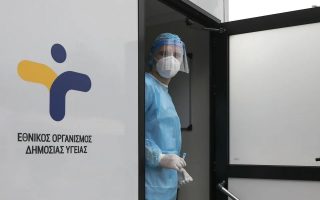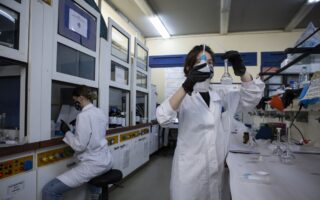Greece forging paths into the great beyond
New space hub, collaborations with NASA, ESA, and record-breaking laser communications

The team from the Institute for Astronomy, Astrophysics, Space Applications and Remote Sensing (IAASARS) of the National Observatory of Athens (NOA) arrived in Thessaloniki ahead of the city’s international trade fair (TIF) with a wealth of optimistic news about the progress of space research and science in Greece.
Shortly before his scheduled talk at the Thessaloniki International Fair, Dr Spyros Vasilakos, director of IAASARS and vice president of NOA’s board of directors, spoke to Kathimerini about the establishment of a new space hub at the Kryoneri Observatory in the northern Peloponnese, which will be the largest in Southeastern Europe.
IAASARS oversees the country’s two largest research telescopes. The first, the Aristarchos Telescope, with a diameter of 2.3 meters, is located at the Helmos Observatory, at the top of Mount Helmos, near Kalavryta, at an altitude of 2,400 meters. Aristarchos is the largest telescope in the Balkans. The second, with a diameter of 1.2 meters, is located at the Kryoneri Observatory at an altitude of about 900 meters. According to Vasilakos, this telescope is what placed IAASARS on the list of the most pioneering space research centers globally when it began observing the moon’s surface to study the impacts of near-Earth objects (NEOs).
“This is a topic of intense concern for space agencies like NASA and the European Space Agency (ESA), as bases are planned on the moon in the coming decades. Therefore, space agencies want to know everything about how these objects impact the lunar surface,” Vasilakos explains.
As part of the activities at the Kryoneri Observatory, which were completed last July, and thanks to IAASARS’s development of space broadband technology, the institute has built a strategic partnership with the ESA.
Telecommunications
Two years ago, Aristarchos was chosen by the ESA as the first European ground station to develop new, fast, and secure optical (laser) telecommunications between Earth and satellites, replacing the current radio wave technology.
“We sent a laser from Aristarchos to Alphasat, the largest European satellite, at a distance of 37,000 kilometers. The satellite ‘saw’ the beam and ‘replied.’ Thus, we became the first station in Europe to perform such a link,” Vasilakos says.
Collaboration with NASA
This achievement paved the way for a new challenge: collaborating with NASA as part of the Psyche mission, following a rigorous evaluation of IAASARS. This NASA Discovery Program space mission aims to explore a metal-rich asteroid of the same name, located in the asteroid belt between Mars and Jupiter. NASA has already launched a spacecraft, now en route to the asteroid.
Notably, the two Greek telescopes involved in this mission are the only European participants.
“This time, we won’t be sending a laser 37,000 kilometers as we did two years ago, but 300 million kilometers – where NASA’s spacecraft will be by 2025. It’s a groundbreaking experiment, and we are preparing intensively,” says Vasilakos.
The experiment will involve both IAASARS facilities. A high-powered laser will be fired from Kryoneri, traveling 300 million kilometers. Upon reaching NASA’s spacecraft, the spacecraft will “respond,” and the signal will be received by Aristarchos at Helmos. Essentially, the powerful laser at Kryoneri will create a massive communication bridge spanning 300 million kilometers.
This link will cover a distance twice that between the Earth and the sun. Along with a similar link from the US, it will form the deepest broadband connection in space ever achieved, opening new frontiers in telecommunications.
Satellite monitoring
In another success for IAASARS, the Kryoneri Observatory has been selected, alongside other European observatories, to provide crucial data to the European Space Operations Center (ESOC) regarding satellite movements around Earth. “There are thousands of satellites orbiting Earth, creating a chaotic situation. That’s why the US and EU have decided to establish a space traffic code. At Kryoneri, we monitor satellite orbits, providing essential data for what’s known as ‘planetary security,’” explains Vasilakos.
Abuzz with activity
While collaborations with the ESA and NASA are well under way, and the Psyche mission is progressing, the Kryoneri Observatory is buzzing with activity. On August 31, two special containers arrived from the Netherlands, delivering the first set of scientific instruments from the ESA, which are vital for NASA’s mission.
These instruments will be installed on newly constructed platforms, completed with support from the Peloponnese Region. This project is backed by €10.8 million from the EU’s Recovery and Resilience Facility (RRF) and €4.3 million from the Peloponnese Region. According to Vasilakos, this cutting-edge equipment will transform the Kryoneri Observatory into the largest space hub in Southeastern Europe.
“A new path is opening – a major national achievement that places us at the forefront of space technology,” says the IAASARS director. The upgraded facilities, along with new buildings and instruments, are expected to be operational by late 2027. Vasilakos envisions the Kryoneri Observatory evolving into a technological park where, beyond research and operational tasks, the public can engage. One of the goals is to welcome school visits, offering students the opportunity to witness science in action.





